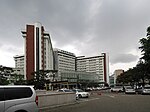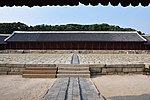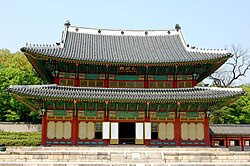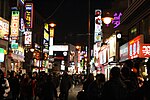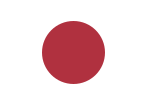Changgyeonggung

Changgyeong Palace is a palace located in Seoul, South Korea. The palace was built in the mid-15th century by King Sejong for his father, Taejong. It was originally named "Suganggung," but it was renovated and enlarged in 1483 by King Seongjong, at which time it received its current name. Many structures were destroyed during Japan's multiple late 15th to 16th (1592) century attempts to conquer Korea and invade China. It was rebuilt by successive Joseon Kings but was once again largely destroyed by the Japanese in the early 20th century. This time, it was torn down methodically to make room for a modern park, a showplace for the empire, akin to Tokyo's Ueno Park. During the Japanese colonial period, the Japanese built a zoo, botanical garden, and museum on the site. It was called "Changgyeongwon park", the "won" standing for the Korean word 'zoo'. After independence in 1945 and the turmoil and destruction of the 1950-53 Korean War, the zoo was restocked through donations of wealthy Koreans as well as gifts from foreign zoos. In 1983, the zoo and botanical garden were relocated to present-day Seoul Grand Park.
Excerpt from the Wikipedia article Changgyeonggung (License: CC BY-SA 3.0, Authors, Images).Changgyeonggung
Changgyeonggung-ro, Seoul Jongno 1·2·3·4(ilisamsa)-ga-dong
Geographical coordinates (GPS) Address Website External links Nearby Places Show on map
Geographical coordinates (GPS)
| Latitude | Longitude |
|---|---|
| N 37.57843 ° | E 126.99598 ° |
Address
창경궁
Changgyeonggung-ro 185
03075 Seoul, Jongno 1·2·3·4(ilisamsa)-ga-dong
South Korea
Open on Google Maps
